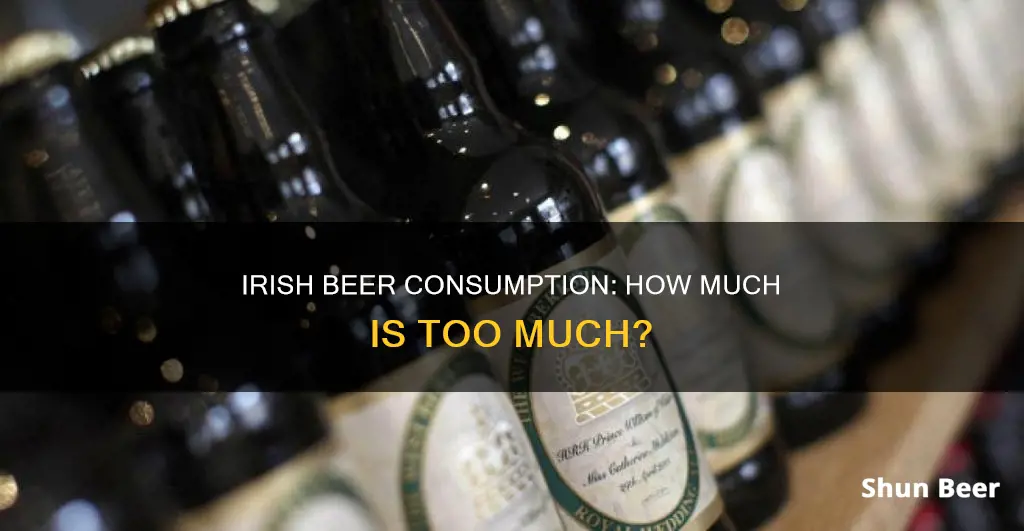
Alcoholism in Ireland is a significant public health problem. According to a recent study, the average Irish person consumes 436 pints of beer annually, which equates to 10.8-10.9 litres of pure alcohol per person per year. This is significantly higher than the government's 2020 target of no more than 9.1 litres. In fact, Ireland is ranked 9th in the world for alcohol consumption and 8th for binge drinking. While alcohol consumption plateaued in 2013, it remains a serious issue, with alcohol abuse creating extensive problems for Irish medical services and contributing to various social concerns.
What You'll Learn

Average beer consumption per year
The average beer consumption per year in Ireland is estimated to be 163 pints per person, according to a study by Euromonitor International. This equates to approximately 93 litres of beer per person annually. However, it is important to note that this figure does not include drinks like cider or craft beer, and it is based on the entire population, including non-drinkers and those who prefer spirits.
When considering the total alcohol consumption in Ireland, the numbers are quite concerning. The country's per capita alcohol consumption is among the highest in Europe, with 70.0% of Irish men and 34.1% of Irish women aged 15 and above considered hazardous drinkers. This means they are at risk of serious harm due to their drinking habits. The Health Research Board (HRB) found that the average Irish person aged 15 and over consumes 10.8 to 10.9 litres of pure alcohol per year, which is significantly higher than the government's 2020 target of no more than 9.1 litres. This amount of alcohol is equivalent to about 436 pints of beer per person per year.
Binge drinking is also a prevalent issue in Ireland, with one in four men and one in ten women reporting drinking more in a single sitting than the recommended maximum weekly limit. Furthermore, more than half of Irish drinkers are classified as hazardous drinkers, yet 74% of them consider themselves light or moderate drinkers. This discrepancy suggests that many individuals may be unaware of the harmful effects of their drinking habits.
Alcohol consumption in Ireland has deep historical roots, influenced by British cultural practices and the country's climate. The mass industrialization of whiskey manufacturing in the 18th century also played a significant role, as whiskey became more affordable and widely consumed. While alcohol remains an important industry for the Irish economy, the country is facing significant public health challenges due to excessive drinking, including high rates of alcohol-related hospitalisations and deaths.
In recent years, there has been a slight decline in overall alcohol consumption in Ireland, which has been attributed to the implementation of taxes on alcoholic beverages. However, when alcohol prices dropped in 2016, consumption levels increased sharply. The COVID-19 pandemic also impacted drinking habits, with a shift from drinking in pubs to drinking at home, which has raised concerns about the potential impact on children's welfare.
Old Beer: Is It Safe to Drink After 30 Years?
You may want to see also

Beer consumption by age and gender
Beer consumption in Ireland varies by age and gender. According to a study by the Health Research Board (HRB), the average Irish person aged 15 and over consumes 10.8 to 10.9 litres of pure alcohol per year, equivalent to about 436 pints of beer. However, it's important to note that one in four adults in Ireland abstain from drinking any alcohol, so the consumption rate per drinker is likely much higher.
When it comes to gender, hazardous drinking is more prevalent among men, with 70.0% of Irish men aged 15 and over falling into this category, compared to 34.1% of Irish women. Men aged 25-34 are the most likely to be hazardous drinkers and are at higher risk of alcohol-related death and self-harm. Binge drinking is also more common among men, with almost one in four engaging in it, compared to one in ten women.
Age also plays a factor in drinking habits. While younger adults tend to drink more overall, older adults, especially those over 65, have higher hazardous drinking rates among those who consume alcohol. Over 40% of men over 65 engage in monthly binge drinking.
Overall, while beer consumption varies by age and gender in Ireland, hazardous and binge drinking are prevalent across different demographic groups, posing significant public health concerns.
Art of Drinking Beer Without Tasting It: A Guide
You may want to see also

Beer consumption by country
Beer is the most widely consumed alcoholic beverage in the world. It is also the third most popular drink globally, after water and tea. Beer consumption varies from country to country, with several factors influencing drinking patterns, such as cultural norms, economic factors, and social dynamics.
According to a study by the Health Research Board (HRB), the average person in Ireland consumes 436 pints of beer annually. This equates to 10.8-10.9 litres of pure alcohol per person per year for those aged 15 and over. While alcohol consumption in Ireland has plateaued since 2013, it still exceeds the government's target of no more than 9.1 litres of pure alcohol per person per year. It is worth noting that one in four adults in Ireland abstain from drinking any alcohol, so the consumption rate per drinker is likely higher than the average.
When it comes to beer consumption per capita, the Czech Republic consistently tops the list. In 2021, the Czech Republic had the highest per capita consumption at 140.12 litres. In 2022, this figure increased slightly to 188.5 litres, maintaining its position as the top per-capita consumer for 30 consecutive years. Austria followed in second place with 101.2 litres per capita in 2022.
China, on the other hand, leads the world in total beer consumption. In 2022, China consumed approximately 34,979 thousand tons of beer, retaining its position as the largest beer-consuming country for the 20th straight year. This can be attributed to its vast population and the increasing popularity of beer in the country.
Beer consumption patterns can vary across different regions and countries, influenced by various cultural, social, and economic factors. While Ireland has a reputation for robust drinking, it is not the highest consumer per capita, and efforts are being made to reduce harmful drinking habits and their impact on public health.
Drinking Four Beers in Four Hours: Safe or Not?
You may want to see also

Beer consumption trends
The Irish certainly enjoy their beer, with the average person consuming a substantial quantity annually. While specific estimates vary, it is clear that beer is a popular beverage of choice in Ireland, contributing significantly to the country's alcohol consumption patterns.
Average Consumption
According to a study by the Health Research Board (HRB), the average Irish person aged 15 and over consumes approximately 436 pints of beer per year. This equates to about 10.8 to 10.9 litres of pure alcohol annually. However, it is important to note that one in four adults in Ireland abstain from drinking any alcohol, so the consumption rate per drinker is likely much higher.
International Comparison
When compared to other countries, Ireland ranks among the top beer-consuming nations. A Euromonitor International study revealed that an Irish person drinks an average of 93 litres of beer (approximately 163 pints) annually. This places Ireland sixth in the world for beer consumption per person, behind the Czech Republic, Germany, Austria, Estonia, and Poland.
Health Implications
While the Irish may enjoy their beer, excessive alcohol consumption has significant health implications. The HRB study highlighted that binge drinking is widespread, especially among young people, and many individuals are unaware of the potential harm associated with their drinking habits. "Hazardous drinking" is prevalent, with 70.0% of Irish men and 34.1% of Irish women aged 15 and over falling into this category. Alcohol abuse creates extensive problems for Irish medical services, and alcoholism is implicated in approximately three deaths per day in the country.
Historical and Cultural Influences
The high levels of alcohol consumption in Ireland have historical and cultural roots. The influence of British cultural practices, particularly during the plantations of Ireland, has been identified as a contributing factor. Additionally, the poor climate of Ireland has also played a role, with drinking often used as a coping mechanism. Pubs have long been associated with masculinity and class, and the mass industrialization of whisky manufacturing in the 18th century, coupled with reduced prices, further exacerbated the problem.
Recent Trends
Since the early 2000s, overall alcohol consumption rates in Ireland have been declining. This decrease has been attributed to the implementation of taxes on alcoholic beverages. However, when beverage prices dropped in 2016, consumption levels surged again. The COVID-19 pandemic also had an impact, with beer consumption decreasing by 17% in 2020 compared to 2019, while wine consumption increased by 12%.
Beer Overload: Kidney Pain and the Brewing Risks
You may want to see also

Alcoholism and public health
Alcoholism in Ireland is a significant public health concern. The average Irish person consumes 436 pints of beer annually, which equates to 10.8-10.9 litres of pure alcohol per person per year. This is significantly higher than the government's 2020 target of no more than 9.1 litres. Ireland is ranked 9th in the world for alcohol consumption and 8th for binge drinking. Binge drinking is a particular issue, with over 58% of drinking occasions resulting in binge drinking. This is defined as consuming more than six standard drinks in one sitting.
The high level of alcohol consumption in Ireland has severe implications for public health. Alcohol is implicated in a variety of social concerns, including physical and sexual assault, domestic violence, and manslaughter. Alcohol is also a factor in adverse outcomes for children, with parental drinking and alcoholism identified as a key problem for child welfare. It is estimated that 11.2% of children with parents who drink excessively have experienced verbal abuse, and nearly 7% have been left in unsafe situations. Alcohol abuse also contributes to family problems, with 20.8% of women aged 18-29 reporting family issues related to alcohol.
Alcohol-related harm is a major cause of health problems in Ireland, with approximately three people dying from alcohol-related causes every day. For men aged 15-39, almost a quarter of all deaths are due to alcohol. More than 1.35 million Irish people engage in harmful drinking practices, and over 30% experience harm from their drinking habits. A study conducted between 1997 and 2010 found that there were 3289 hospital admissions due to acute alcohol problems, with 43.6% of patients under 30 years old and over 10% under 18. Alcohol-related discharges from hospitals increased by 94.8% from 1995 to 2018, demonstrating the growing burden on the healthcare system.
Alcoholism has a significant impact on the workplace, with many young people reporting negative consequences due to co-workers' alcohol dependence or addiction. About 15% of women and 8% of men aged 18-34 state that their work and employment obligations are affected by colleagues' drinking. The economic benefits of the alcohol industry in Ireland are substantial, with exports worth over 1 billion euros and the creation of over 92,000 jobs. However, the social and health costs of alcohol abuse are also considerable.
Parking Lot Beer: Is It Legal to Drink?
You may want to see also
Frequently asked questions
On average, a person in Ireland drinks 436 pints of beer every year. This is the equivalent of 10.8-10.9 litres of pure alcohol per person per year.
According to a study by Euromonitor International, Ireland is one of the top beer-drinking countries in the world. Only the Czech Republic, Germany, Austria, Estonia, and Poland drink more beer per person.
Alcoholism is a significant public health problem in Ireland, with 70.0% of Irish men and 34.1% of Irish women aged 15+ considered hazardous drinkers. Alcohol abuse creates extensive problems for Irish medical services and is implicated in at least three deaths per day in Ireland.







